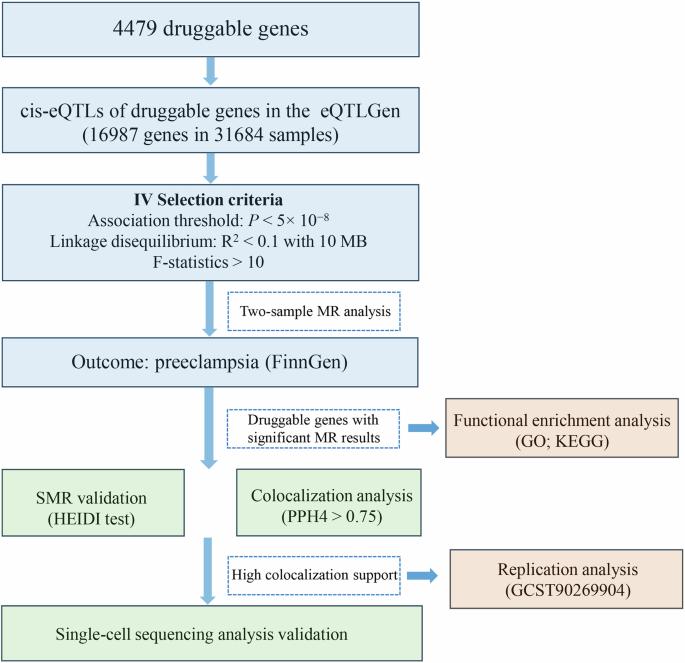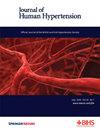通过基因分析探索子痫前期的潜在治疗靶基因。
IF 3.4
4区 医学
Q2 PERIPHERAL VASCULAR DISEASE
引用次数: 0
摘要
子痫前期(PE)是一种普遍和严重的妊娠相关并发症,有效的干预目标仍然有限,对孕产妇和胎儿健康构成重大风险。本研究旨在通过基因分析发现潜在的治疗靶基因。具体来说,我们利用从eQTLGen联盟获得的血液样本中获得的可用药基因的顺式表达数量性状位点(cis-eQTL)作为暴露数据。随后,进行孟德尔随机化(MR)分析,以探索这些可用药基因与PE之间的因果关系。利用功能富集分析、基于summary -data的MR (SMR)和共定位分析对鉴定的基因进行验证。磁共振结果显示17个可药物基因在多次测试校正(FDR)后与PE显著相关本文章由计算机程序翻译,如有差异,请以英文原文为准。

Exploration of potential therapeutic target genes for preeclampsia through genetic analysis
Preeclampsia (PE) is a prevalent and severe pregnancy-related complication, for which effective intervention targets remain limited, posing significant risks to maternal and fetal health. This study aimed to identify potential therapeutic target genes through genetic analyses. Specifically, we utilized cis-expression quantitative trait loci (cis-eQTL) of druggable genes derived from blood samples obtained from the eQTLGen consortium as exposure data. Subsequently, Mendelian randomization (MR) analysis was conducted to explore causal associations between these druggable genes and PE. Functional enrichment analysis, Summary-data-based MR (SMR), and colocalization analysis were employed to validate the identified genes. MR results revealed 17 druggable genes significantly associated with PE after multiple testing correction (FDR < 0.05). Functional enrichment analysis indicated that these genes are involved in key biological processes such as leukocyte proliferation and activation, immune response regulation, and the metabolism of water-soluble vitamins. Additionally, they were found to participate in several critical signaling pathways, including the complement and coagulation cascades, the renin-angiotensin system, and folate biosynthesis. SMR and colocalization analyses further confirmed the causal relationships between PE and five genes—TESK2, LNPEP, CD320, NELL2, and SF3B3. Moreover, single-cell RNA sequencing data supported the association between the expression levels of TESK2, CD320, and SF3B3 and the development of PE. This study provides preliminary evidence identifying several potential genetic targets that may help reduce the risk of PE from a genomic perspective. These findings offer novel scientific insights and research directions for future drug development and the optimization of therapeutic strategies aimed at managing and preventing PE.
求助全文
通过发布文献求助,成功后即可免费获取论文全文。
去求助
来源期刊

Journal of Human Hypertension
医学-外周血管病
CiteScore
5.20
自引率
3.70%
发文量
126
审稿时长
6-12 weeks
期刊介绍:
Journal of Human Hypertension is published monthly and is of interest to health care professionals who deal with hypertension (specialists, internists, primary care physicians) and public health workers. We believe that our patients benefit from robust scientific data that are based on well conducted clinical trials. We also believe that basic sciences are the foundations on which we build our knowledge of clinical conditions and their management. Towards this end, although we are primarily a clinical based journal, we also welcome suitable basic sciences studies that promote our understanding of human hypertension.
The journal aims to perform the dual role of increasing knowledge in the field of high blood pressure as well as improving the standard of care of patients. The editors will consider for publication all suitable papers dealing directly or indirectly with clinical aspects of hypertension, including but not limited to epidemiology, pathophysiology, therapeutics and basic sciences involving human subjects or tissues. We also consider papers from all specialties such as ophthalmology, cardiology, nephrology, obstetrics and stroke medicine that deal with the various aspects of hypertension and its complications.
 求助内容:
求助内容: 应助结果提醒方式:
应助结果提醒方式:


